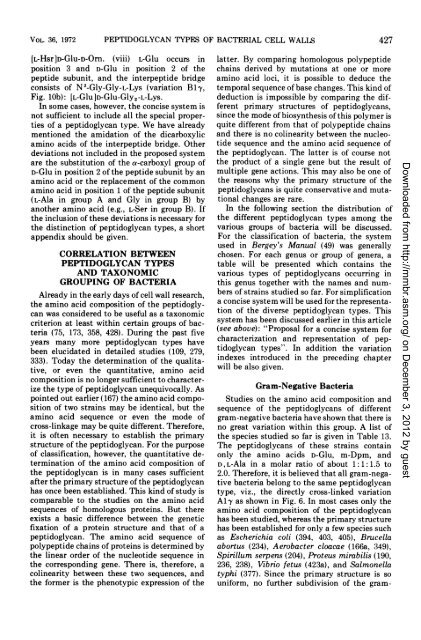Peptidoglycan .Types of Bacterial Cell Walls and their Taxonomic ...
Peptidoglycan .Types of Bacterial Cell Walls and their Taxonomic ...
Peptidoglycan .Types of Bacterial Cell Walls and their Taxonomic ...
You also want an ePaper? Increase the reach of your titles
YUMPU automatically turns print PDFs into web optimized ePapers that Google loves.
VOLR 36, 1972 PEPTIDOGLYCAN TYPES OF BACTERIAL CELL WALLS<br />
427<br />
[L-Hsr]D-Glu-D-Orn. (viii) L-Glu occurs in<br />
position 3 <strong>and</strong> D-Glu in position 2 <strong>of</strong> the<br />
peptide subunit, <strong>and</strong> the interpeptide bridge<br />
consists <strong>of</strong> N2-Gly-Gly-L-Lys (variation B1iy,<br />
Fig. 10b): [L-Glu]D-Glu-Gly2-L-Lys.<br />
In some cases, however, the concise system is<br />
not sufficient to include all the special properties<br />
<strong>of</strong> a peptidoglycan type. We have already<br />
mentioned the amidation <strong>of</strong> the dicarboxylic<br />
amino acids <strong>of</strong> the interpeptide bridge. Other<br />
deviations not included in the proposed system<br />
are the substitution <strong>of</strong> the a-carboxyl group <strong>of</strong><br />
D-Glu in position 2 <strong>of</strong> the peptide subunit by an<br />
amino acid or the replacement <strong>of</strong> the common<br />
amino acid in position 1 <strong>of</strong> the peptide subunit<br />
(L-Ala in group A <strong>and</strong> Gly in group B) by<br />
another amino acid (e.g., L-Ser in group B). If<br />
the inclusion <strong>of</strong> these deviations is necessary for<br />
the distinction <strong>of</strong> peptidoglycan types, a short<br />
appendix should be given.<br />
CORRELATION BETWEEN<br />
PEPTIDOGLYCAN TYPES<br />
AND TAXONOMIC<br />
GROUPING OF BACTERIA<br />
Already in the early days <strong>of</strong> cell wall research,<br />
the amino acid composition <strong>of</strong> the peptidoglycan<br />
was considered to be useful as a taxonomic<br />
criterion at least within certain groups <strong>of</strong> bacteria<br />
(75, 173, 358, 428). During the past five<br />
years many more peptidoglycan types have<br />
been elucidated in detailed studies (109, 279,<br />
333). Today the determination <strong>of</strong> the qualitative,<br />
or even the quantitative, amino acid<br />
composition is no longer sufficient to characterize<br />
the type <strong>of</strong> peptidoglycan unequivocally. As<br />
pointed out earlier (167) the amino acid composition<br />
<strong>of</strong> two strains may be identical, but the<br />
amino acid sequence or even the mode <strong>of</strong><br />
cross-linkage may be quite different. Therefore,<br />
it is <strong>of</strong>ten necessary to establish the primary<br />
structure <strong>of</strong> the peptidoglycan. For the purpose<br />
<strong>of</strong> classification, however, the quantitative determination<br />
<strong>of</strong> the amino acid composition <strong>of</strong><br />
the peptidoglycan is in many cases sufficient<br />
after the primary structure <strong>of</strong> the peptidoglycan<br />
has once been established. This kind <strong>of</strong> study is<br />
comparable to the studies on the amino acid<br />
sequences <strong>of</strong> homologous proteins. But there<br />
exists a basic difference between the genetic<br />
fixation <strong>of</strong> a protein structure <strong>and</strong> that <strong>of</strong> a<br />
peptidoglycan. The amino acid sequence <strong>of</strong><br />
polypeptide chains <strong>of</strong> proteins is determined by<br />
the linear order <strong>of</strong> the nucleotide sequence in<br />
the corresponding gene. There is, therefore, a<br />
colinearity between these two sequences, <strong>and</strong><br />
the former is the phenotypic expression <strong>of</strong> the<br />
latter. By comparing homologous polypeptide<br />
chains derived by mutations at one or more<br />
amino acid loci, it is possible to deduce the<br />
temporal sequence <strong>of</strong> base changes. This kind <strong>of</strong><br />
deduction is impossible by comparing the different<br />
primary structures <strong>of</strong> peptidoglycans,<br />
since the mode <strong>of</strong> biosynthesis <strong>of</strong> this polymer is<br />
quite different from that <strong>of</strong> polypeptide chains<br />
<strong>and</strong> there is no colinearity between the nucleotide<br />
sequence <strong>and</strong> the amino acid sequence <strong>of</strong><br />
the peptidoglycan. The latter is <strong>of</strong> course not<br />
the product <strong>of</strong> a single gene but the result <strong>of</strong><br />
multiple gene actions. This may also be one <strong>of</strong><br />
the reasons why the primary structure <strong>of</strong> the<br />
peptidoglycans is quite conservative <strong>and</strong> mutational<br />
changes are rare.<br />
In the following section the distribution <strong>of</strong><br />
the different peptidoglycan types among the<br />
various groups <strong>of</strong> bacteria will be discussed.<br />
For the classification <strong>of</strong> bacteria, the system<br />
used in Bergey's Manual (49) was generally<br />
chosen. For each genus or group <strong>of</strong> genera, a<br />
table will be presented which contains the<br />
various types <strong>of</strong> peptidoglycans occurring in<br />
this genus together with the names <strong>and</strong> numbers<br />
<strong>of</strong> strains studied so far. For simplification<br />
a concise system will be used for the representation<br />
<strong>of</strong> the diverse peptidoglycan types. This<br />
system has been discussed earlier in this article<br />
(see above): "Proposal for a concise system for<br />
characterization <strong>and</strong> representation <strong>of</strong> peptidoglycan<br />
types". In addition the variation<br />
indexes introduced in the preceding chapter<br />
will be also given.<br />
Gram-Negative Bacteria<br />
Studies on the amino acid composition <strong>and</strong><br />
sequence <strong>of</strong> the peptidoglycans <strong>of</strong> different<br />
gram-negative bacteria have shown that there is<br />
no great variation within this group. A list <strong>of</strong><br />
the species studied so far is given in Table 13.<br />
The peptidoglycans <strong>of</strong> these strains contain<br />
only the amino acids D-Glu, m-Dpm, <strong>and</strong><br />
D,L-Ala in a molar ratio <strong>of</strong> about 1:1:1.5 to<br />
2.0. Therefore, it is believed that all gram-negative<br />
bacteria belong to the same peptidoglycan<br />
type, viz., the directly cross-linked variation<br />
Aly as shown in Fig. 6. In most cases only the<br />
amino acid composition <strong>of</strong> the peptidoglycan<br />
has been studied, whereas the primary structure<br />
has been established for only a few species such<br />
as Escherichia coli (394, 403, 405), Brucella<br />
abortus (234), Aerobacter cloacae (166a, 349),<br />
Spirillum serpens (204), Proteus mirabilis (190,<br />
236, 238), Vibrio fetus (423a), <strong>and</strong> Salmonella<br />
typhi (377). Since the primary structure is so<br />
uniform, no further subdivision <strong>of</strong> the gram-<br />
Downloaded from<br />
http://mmbr.asm.org/<br />
on December 3, 2012 by guest




